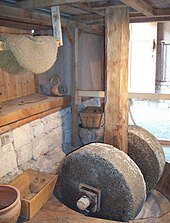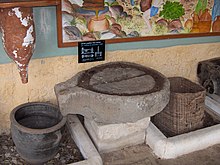Olive oil
From Wikipedia, the free encyclopedia
Olive oil
|
|

A bottle of olive oil
|
|
Fat composition
|
|
Palmitic acid: 7.5–20.0%
Stearic acid: 0.5–5.0% Arachidic acid: <0.6% Behenic acid: <0.3% Myristic acid: <0.05% Lignoceric acid: <0.2% |
|
yes
|
|
Oleic acid: 55.0–83.0%
Palmitoleic acid: 0.3–3.5% |
|
Properties
|
|
Food energy per 100 g
|
3,700 kJ
(880 kcal)
|
−6 °C (21.2 °F)
|
|
300 °C (572 °F)
|
|
190 °C (374 °F) (virgin)
210 °C (410 °F)(refined) |
|
Specific gravity at 20 °C
|
0.9150–0.9180 (@
15.5 °C)
|
Viscosity at 20 °C
|
84 cP
|
1.4677–1.4705 (virgin
and refined)
1.4680–1.4707 (pomace) |
|
75–94 (virgin and
refined)
75–92 (pomace) |
|
maximum: 6.6 (refined and pomace)
0.6 (extra-virgin) |
|
184–196 (virgin and
refined)
182–193 (pomace) |
|
20 (virgin)
10 (refined and pomace) |
|
Olive oil is a fat
obtained from the olive (the
fruit of Olea europaea;
family Oleaceae), a traditional tree crop of
the Mediterranean Basin.
The oil is produced by grinding whole olives and extracting the oil by
mechanical or chemical means. It is commonly used in cooking, cosmetics, pharmaceuticals, and soaps and
as a fuel for traditional oil lamps. Olive oil is used throughout the
world, but especially in the Mediterranean countries and, in
particular, in Greece where the largest consumption per
person can be found.
History
Early cultivation
The olive tree is
native to the Mediterranean basin; wild olives were collected by Neolithic peoples as early as the 8th
millennium BC.[1] The wild olive tree originated
in Asia Minor[2] in ancient Greece.
It is not clear when
and where olive trees were first domesticated: in Asia Minor in the 6th
millennium; along the Levantine coast
stretching from the Sinai Peninsula to
modern Turkey in the 4th millennium;[1] or somewhere in the Mesopotamian Fertile Crescent in the 3rd millennium.

Ancient Greek olive
oil production workshop inKlazomenai, Ionia (modern Turkey)
A widespread view
exists that the first cultivation took place on the island ofCrete.
Archeological evidence suggest that olives were being grown in Crete as long
ago as 2,500 BC. The earliest surviving olive oil amphorae date to 3500 BC (Early Minoan
times), though the production of olive is assumed to have started before 4000
BC. An alternative view retains that olives were turned into oil by 4500 BC by Canaanites in present-day Israel.[3] Until 1500 BC, eastern coastal
areas of the Mediterranean were most heavily cultivated. Olive trees were
certainly cultivated by the Late Minoan period (1500 BC) in Crete,
and perhaps as early as the Early Minoan.[4] The cultivation of olive trees
in Crete became particularly intense in the post-palatial period and played an
important role in the island's economy.
Recent genetic
studies suggest that species used by modern cultivators descend from multiple
wild populations, but a detailed history of domestication is not yet
understood.[5]
Production and trade

Ancient oil press
(Bodrum Museum of Underwater Archaeology, Bodrum, Turkey)
Olive trees and oil
production in the Eastern Mediterranean can be traced to archives of the
ancient city-state Ebla (2600–2240 BC), which were located
on the outskirts of the Syrian cityAleppo. Here some dozen documents dated 2400 BC describe
lands of the king and the queen. These belonged to a library of clay tablets
perfectly preserved by having been baked in the fire that destroyed the palace.
A later source is the frequent mentions of oil in Tanakh.[citation needed]
Dynastic Egyptians before 2000 BC imported olive
oil from Crete, Syria and Canaan and oil was an
important item of commerce and wealth. Remains of olive oil have been found in
jugs over 4,000 years old in a tomb on the island of Naxos in the Aegean Sea. Sinuhe, the Egyptian exile who lived in northern Canaan about
1960 BC, wrote of abundant olive trees.[6]
Besides food, olive
oil has been used for religious rituals, medicines, as a fuel in oil lamps, soap-making, and skin care application. The
Minoans used olive oil in religious ceremonies. The oil became a principal
product of theMinoan civilization,
where it is thought to have represented wealth. The Minoans put the pulp into settling tanksand, when the oil had risen to
the top, drained the water from the bottom.[citation needed] Olive
tree growing reached Iberia and Etruscan cities
well before the 8th century BC through trade with the Phoenicians and Carthage, then spread into Southern Gaul by
the Celtic tribes during the 7th century BC.
The first recorded
oil extraction is known from the Hebrew Bible and took place during the Exodus from Egypt, during the 13th
century BC. During this time, the oil was derived through hand-squeezing the
berries and stored in special containers under guard of the priests. A
commercial mill for non-sacramental use of oil was in use in the tribal
Confederation and later in 1000 BC, the fertile crescent, and area consisting of
present day Palestine, Lebanon, and Israel. Over 100 olive presses have been found
in Tel Miqne (Ekron), where the Biblical Philistines also produced oil. These
presses are estimated to have had output of between 1,000 and 3,000 tons
of olive oil per season.
Many ancient presses
still exist in the Eastern Mediterranean region, and some dating to the Roman
period are still in use today.[citation needed]

Olive crusher (trapetum) in
Pompeii (79 AD)
Olive oil was common
in ancient Greek and Roman cuisine.
According to Herodotus, Apollodorus, Plutarch,Pausanias, Ovid and
other sources, the city of Athens obtained its
name because Athenians considered olive oil essential, preferring the offering
of the goddess Athena (an olive tree) over the offering
of Poseidon (a spring of saltwater
gushing out of a cliff). The Spartans and other
Greeks used oil to rub themselves while exercising in thegymnasia.
From its beginnings early in the 7th century BC, the cosmetic use of olive oil
quickly spread to all of Hellenic city states, together with naked appearance
of athletes, and lasted close to a thousand years despite its great expense.[7][8] Olive trees were planted in the
entire Mediterranean basin during evolution of the Roman republic and empire. According to the historian Pliny, Italy had "excellent olive oil at
reasonable prices" by the 1st century AD, "the best in the
Mediterranean", he maintained.

The Manufacture of
Oil, 16th=century engraving by J. Amman
The importance and
antiquity of olive oil can be seen in the fact that the English word oil derives
from c. 1175, olive oil, from Anglo-Fr. and O.N.Fr. olie,
from O.Fr. oile (12c., Mod.Fr. huile), from L. oleum "oil,
olive oil" (cf. It. olio), from Gk.elaion "olive
tree",[9] which may have been borrowed
through trade networks from the Semitic Phoenician use of el'yonmeaning
"superior", probably in recognized comparison to other vegetable or
animal fats available at the time. Robin Lane Fox suggests[10] that the Latin borrowing of
Greek elaion for oil (Latin oleum) is itself a
marker for improved Greek varieties of oil-producing olive, already present in
Italy as Latin was forming, brought by Euboean traders, whose presence in Latium is signaled
by remains of their characteristic pottery, from the mid-8th century.


No comments:
Post a Comment